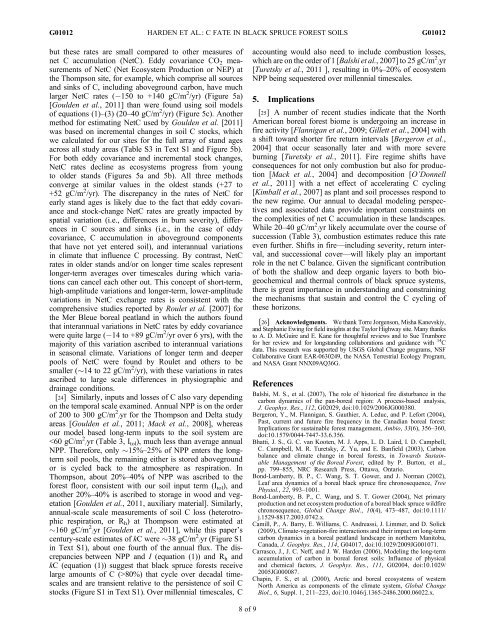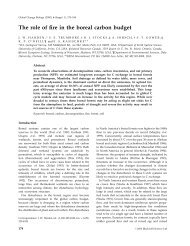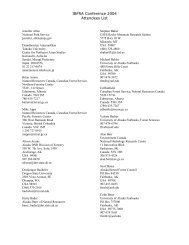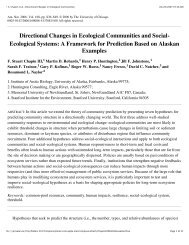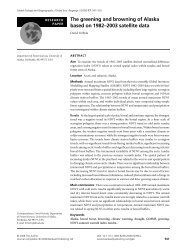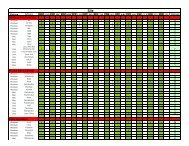G01012 HARDEN ET AL.: C FATE IN BLACK SPRUCE FOREST SOILS G01012 but these rates are small compared to other measures of net C accumulation (NetC). Eddy covariance CO 2 measurements of NetC (Net Ecosystem Production or NEP) at the Thompson site, for example, which comprise all sources and sinks of C, including aboveground carbon, have much larger NetC rates ( 150 to +140 gC/m 2 /yr) (Figure 5a) [Goulden et al., 2011] than were found using soil models of equations (1)–(3) (20–40 gC/m 2 /yr) (Figure 5c). Another method for estimating NetC used by Goulden et al. [2011] was based on incremental changes in soil C stocks, which we calculated for our sites for the full array of stand ages across all study areas (Table S3 in Text S1 and Figure 5b). For both eddy covariance and incremental stock changes, NetC rates decline as ecosystems progress from young to older stands (Figures 5a and 5b). All three methods converge at similar values in the oldest stands (+27 to +52 gC/m 2 /yr). The discrepancy in the rates of NetC for early stand ages is likely due to the fact that eddy covariance and stock-change NetC rates are greatly impacted by spatial variation (i.e., differences in burn severity), differences in C sources and sinks (i.e., in the case of eddy covariance, C accumulation in aboveground components that have not yet entered soil), and interannual variations in climate that influence C processing. By contrast, NetC rates in older stands and/or on longer time scales represent longer-term averages over timescales during which variations can cancel each other out. This concept of short-term, high-amplitude variations and longer-term, lower-amplitude variations in NetC exchange rates is consistent with the comprehensive studies reported by Roulet et al. [2007] for the Mer Bleue boreal peatland in which the authors found that interannual variations in NetC rates by eddy covariance were quite large ( 14 to +89 gC/m 2 /yr over 6 yrs), with the majority of this variation ascribed to interannual variations in seasonal climate. Variations of longer term and deeper pools of NetC were found by Roulet and others to be smaller (14 to 22 gC/m 2 /yr), with these variations in rates ascribed to large scale differences in physiographic and drainage conditions. [24] Similarly, inputs and losses of C also vary depending on the temporal scale examined. Annual NPP is on the order of 200 to 300 gC/m 2 /yr for the Thompson and Delta study areas [Goulden et al., 2011; Mack et al., 2008], whereas our model based long-term inputs to the soil system are 80%) that cycle over decadal timescales and are transient relative to the persistence of soil C stocks (Figure S1 in Text S1). Over millennial timescales, C accounting would also need to include combustion losses, which are on the order of 1 [Balshi et al., 2007] to 25 gC/m 2 /yr [Turetsky et al., 2011 ], resulting in 0%–20% of ecosystem NPP being sequestered over millennial timescales. 5. Implications [25] A number of recent studies indicate that the North American boreal forest biome is undergoing an increase in fire activity [Flannigan et al., 2009; Gillett et al., 2004] with a shift toward shorter fire return intervals [Bergeron et al., 2004] that occur seasonally later and with more severe burning [Turetsky et al., 2011]. Fire regime shifts have consequences for not only combustion but also for production [Mack et al., 2004] and decomposition [O’Donnell et al., 2011] with a net effect of accelerating C cycling [Kimball et al., 2007] as plant and soil processes respond to the new regime. Our annual to decadal modeling perspectives and associated data provide important constraints on the complexities of net C accumulation in these landscapes. While 20–40 gC/m 2 /yr likely accumulate over the course of succession (Table 3), combustion estimates reduce this rate even further. Shifts in fire—including severity, return interval, and successional cover—will likely play an important role in the net C balance. Given the significant contribution of both the shallow and deep organic layers to both biogeochemical and thermal controls of black spruce systems, there is great importance in understanding and constraining the mechanisms that sustain and control the C cycling of these horizons. [26] Acknowledgments. We thank Torre Jorgenson, Misha Kanevskiy, and Stephanie Ewing for field insights at the Taylor Highway site. Many thanks to A. D. McGuire and E. Kane for thoughtful reviews and to Sue Trumbore for her review and for longstanding collaborations and guidance with 14 C data. This research was supported by USGS Global Change programs, NSF Collaborative Grant EAR-0630249, the NASA Terrestrial Ecology Program, and NASA Grant NNX09AQ36G. References Balshi, M. S., et al. (2007), The role of historical fire disturbance in the carbon dynamics of the pan-boreal region: A process-based analysis, J. Geophys. Res., 112, G02029, doi:10.1029/2006JG000380. Bergeron, Y., M. Flannigan, S. Gauthier, A. Leduc, and P. Lefort (2004), Past, current and future fire frequency in the Canadian boreal forest: Implications for sustainable forest management, Ambio, 33(6), 356–360, doi:10.1579/0044-7447-33.6.356. Bhatti, J. S., G. C. van Kooten, M. J. Apps, L. D. Laird, I. D. Campbell, C. Campbell, M. R. Turetsky, Z. Yu, and E. Banfield (2003), Carbon balance and climate change in boreal forests, in Towards Sustainable Management of the Boreal Forest, edited by P. Burton, et al., pp. 799–855, NRC Research Press, Ottawa, Ontario. Bond-Lamberty, B. P., C. Wang, S. T. Gower, and J. Norman (2002), Leaf area dynamics of a boreal black spruce fire chronosequence, Tree Physiol., 22, 993–1001. Bond-Lamberty, B. P., C. Wang, and S. T. Gower (2004), Net primary production and net ecosystem production of a boreal black spruce wildfire chronosequence, Global Change Biol., 10(4), 473–487, doi:10.1111/ j.1529-8817.2003.0742.x. Camill, P., A. Barry, E. Williams, C. Andreassi, J. Limmer, and D. Solick (2009), Climate-vegetation-fire interactions and their impact on long-term carbon dynamics in a boreal peatland landscape in northern Manitoba, Canada, J. Geophys. Res., 114, G04017, doi:10.1029/2009JG001071. Carrasco, J., J. C. Neff, and J. W. <strong>Harden</strong> (2006), Modeling the long-term accumulation of carbon in boreal forest soils: Influence of physical and chemical factors, J. Geophys. Res., 111, G02004, doi:10.1029/ 2005JG000087. Chapin, F. S., et al. (2000), Arctic and boreal ecosystems of western North America as components of the climate system, Global Change Biol., 6, Suppl. 1, 211–223, doi:10.1046/j.1365-2486.2000.06022.x. 8of9
G01012 HARDEN ET AL.: C FATE IN BLACK SPRUCE FOREST SOILS G01012 Czimczik, C. I., S. E. Trumbore, M. S. Carbone, and G. C. Winston (2006), Changing sources of soil respiration with time since fire in a boreal forest, Global Change Biol., 12,957–971, doi:10.1111/j.1365-2486.2006.01107.x. Daly, C., G. H. Taylor, W. P. Gibson, T. W. Parzybok, G. L. <strong>Johnson</strong>, and P. Pasteris (2001), High quality spatial climate data sets for the United States and beyond, Trans. ASAE, 43, 1957–1962. Flannigan, M., B. Stocks, M. Turetsky, and M. Wotton (2009), Impacts of climate change on fire activity and fire management in the circumboreal forest, Global Change Biol., 15(3), 549–560, doi:10.1111/j.1365- 2486.2008.01660.x. Gillett, N. P., A. J. Weaver, F. W. Zwiers, and M. D. Flannigan (2004), Detecting the effect of climate change on Canadian forest fires, Geophys. Res. Lett., 31(18), L18211, doi:10.1029/2004GL020876. Goulden, M. L., G. C. Winston, A. M. S. McMillan, M. E. Litvak, E. L. Read, A. V. Rocha, and E. J. Rob (2006), An eddy covariance mesonet to measure the effect of forest age on land-atmosphere exchange, Global Change Biol., 12(11), 2146–2162, doi:10.1111/ j.1365-2486.2006.01251.x. Goulden, M. L., A. M. S. McMillan, G. C. Winston, A. V. Rocha, K. L. <strong>Manies</strong>, J. W. <strong>Harden</strong>, and B. P. Bond-Lamberty (2011), Patterns of NPP, GPP, respiration, and NEP during boreal forest succession, Global Change Biol., 17(2), 855–871, doi:10.1111/j.1365-2486.2010.02274.x. <strong>Harden</strong>, J. W., K. P. O’Neill, S. E. Trumbore, H. Veldhuis, and B. J. Stocks (1997), Moss and soil contributions to the annual net carbon flux of a maturing boreal forest, J. Geophys. Res., 102(D24), 28,805–28,816, doi:10.1029/97JD02237. <strong>Harden</strong>, J. W., M. Mack, H. Veldhuis, and S. T. Gower (2003), Fire dynamics and implications for nitrogen cycling in boreal forests, J. Geophys. Res., 108(D3), 8223, doi:10.1029/2001JD000494. <strong>Johnson</strong>, K. D., et al. (2011), Soil carbon distribution in Alaska in relation to soil-forming factors, Geoderma, 167–168, 71–84, doi:10.1016/j. geoderma.2011.10.006. Kane, E. S., and J. Vogel (2009), Patterns of total ecosystem carbon storage with changes in soil temperature in boreal black spruce forests, Ecosystems (N. Y.), 12(2), 322–335, doi:10.1007/s10021-008-9225-1. Kashian, D. M., W. H. Romme, D. B. Tinker, M. G. Turner, and M. G. Ryan (2006), Carbon storage on landscapes with stand-replacing fires, BioScience, 56(7), 598–606, doi:10.1641/0006-3568(2006)56[598: CSOLWS]2.0.CO;2. Kasischke, E. S., and J. F. Johnstone (2005), Variation in postfire organic layer thickness in a black spruce forest complex in interior Alaska and its effects on soil temperature and moisture, Can. J. For. Res., 35, 2164–2177, doi:10.1139/x05-159. Kimball, J. S., et al. (2007), Recent climate-driven increases in vegetation productivity for the western arctic: Evidence of an acceleration of the northern terrestrial carbon cycle, Earth Interact., 11(4), 1–30, doi:10.1175/ EI180.1. Mack, M. C., E. A. G. Schuur, M. S. Bret-Harte, G. R. Shaver, and F. S. I. Chapin (2004), Carbon storage in arctic tundra reduced by long-term nutrient fertilization, Nature, 431, 440–443, doi:10.1038/nature02887. Mack, M. C., K. K. Treseder, K. L. <strong>Manies</strong>, J. W. <strong>Harden</strong>, E. A. G. Schuur, J. G. Vogel, J. T. Randerson, and F. S. Chapin III (2008), Recovery of aboveground plant biomass and productivity after fire in mesic and dry black spruce forests of interior Alaska, Ecosystems (N. Y.), 11(2), 209–225, doi:10.1007/s10021-007-9117-9. <strong>Manies</strong>, K. L., J. W. <strong>Harden</strong>, S. R. Silva, P. H. Briggs, and B. M. Schmid (2004), Soil data from Picea mariana stands near Delta Junction, Alaska, of different ages and soil drainage types, Open File Rep., 2004-1271, 19 pp, U.S. Geol. Surv., Reston, Va. [Available at http://pubs.usgs.gov/ of/2004/1271/of2004-1271.pdf.] <strong>Manies</strong>, K. L., J. W. <strong>Harden</strong>, and H. Veldhuis (2006), Soil data from a moderately well and somewhat poorly drained fire chronosequence near Thompson, Manitoba, Canada, Open File Rep., 2006-1291, 17 pp., U.S. Geol. Surv., Reston, Va. [Available at http://pubs.usgs.gov/of/ 2006/1291/of2006-1291.pdf.] McGuire, A. D., L. G. Anderson, T. R. Christensen, S. Dallimore, L. D. Guo, D. J. Hayes, M. Heimann, T. D. Lorenson, R. W. Macdonald, and N. Roulet (2009), Sensitivity of the carbon cycle in the Arctic to climate change, Ecol. Monogr., 79(4), 523–555, doi:10.1890/08-2025.1. O’Donnell, J. A., V. E. Romanovsky, J. W. <strong>Harden</strong>, and A. D. McGuire (2009), The effect of soil moisture content on the thermal conductivity of soil organic horizons from black spruce ecosystems in interior Alaska, Soil Sci., 174, 646–651, doi:10.1097/SS.0b013e3181c4a7f8. O’Donnell, J. A., J. W. <strong>Harden</strong>, A. D. McGuire, and V. E. Romanovsky (2010), Exploring the sensitivity of soil carbon dynamics to climate change, fire disturbance, and permafrost thaw in a black spruce ecosystem, Biogeosciences, 7, 8853–8893, doi:10.5194/bgd-7-8853-2010. O’Donnell, J. A., J. W. <strong>Harden</strong>, A. D. McGuire, M. Z. Kanevskiy, and M. T. Jorgenson (2011), The effect of fire and permafrost interactions on soil carbon accumulation in an upland black spruce ecosystem of interior Alaska: Implications for post-thaw carbon loss, Global Change Biol., 17, 1461–1474, doi:10.1111/j.1365-2486.2010.02358.x. O’Neill, K. P., D. Richter, and E. Kasischke (2006), Succession-driven changes in soil respiration following fire in black spruce stands of interior Alaska, Biogeochemistry, 80(1), 1–20, doi:10.1007/s10533-005-5964-7. Parton, W. J., D. S. Ojima, C. V. Cole, and D. S. Schimel (1994), A general model for soil organic matter dynamics: Sensitivity to litter chemistry, texture, and management, in Quantitative Modeling of Soil Forming Processes, edited by R. B. Bryant and R. W. Arnold, pp. 147–167, Soil Sci. Soc. of Am., Madison, Wisc. Péwé, T. L., and G. W. Holmes (1964), Geology of the Mt. Hayes D–4 quadrangle, Alaska, Misc. Geol. Invest. Map., I-394. 2 pp., U.S. Geol. Surv., Reston, Va. Roulet, N. T., P. M. Lafleurs, P. J. H. Richard, T. R. Moore, E. R. Humphreys, and J. Bubier (2007), Contemporary carbon balance and late Holocene carbon accumulation in a northern peatland, Global Change Biol., 13, 397–411, doi:10.1111/j.1365-2486.2006.01292.x. Sellers, P. J., et al. (1997), BOREAS in 1997: Experiment overview, scientific results, and future directions, J. Geophys. Res., 102(D24), 28,731–28,769, doi:10.1029/97JD03300. Shetler, G., M. R. Turetsky, E. Kane, and E. Kasischke (2008), Sphagnum mosses limit total carbon consumption during fire in Alaskan black spruce forests, Can. J. For. Res., 38(8), 2328–2336, doi:10.1139/X08-057. Stuiver, M., and H. A. Polach (1977), Discussion reporting of 14 C data, Radiocarbon, 19(3), 355–363. Tarnocai, C., J. G. Canadell, E. A. G. Schuur, P. Kuhry, G. Mazhitova, and S. Zimov (2009), Soil organic carbon pools in the northern circumpolar permafrost region, Global Biogeochem. Cycles, 23, GB2023, doi:10.1029/2008GB003327. Trumbore, S. E., and J. W. <strong>Harden</strong> (1997), Accumulation and turnover of carbon in organic and mineral soils of the BOREAS northern study site, J. Geophys. Res., 102(D24), 28,817–28,830, doi:10.1029/97JD02231. Trumbore, S. E., E. A. Davidson, P. B. Decamargo, D. C. Nepstad, and L. A. Martinelli (1995), Belowground cycling of carbon in forests and pastures of eastern Amazonia, Global Biogeochem. Cycles, 9(4), 515–528, doi:10.1029/95GB02148. Turetsky, M. R., M. C. Mack, J. W. <strong>Harden</strong>, and K. L. <strong>Manies</strong> (2005), Spatial patterning of soil carbon storage across boreal landscapes, in Ecosystem Function in Heterogeneous Landscapes, edited by G. M. Lovett, et al., pp. 229–255, Springer, New York, doi:10.1007/0-387- 24091-8_12. Turetsky, M. R., E. S. Kane, J. W. <strong>Harden</strong>, R. D. Ottmar, K. L. <strong>Manies</strong>, E. Hoy, and E. S. Kasischke (2011), Recent acceleration of biomass burning and carbon losses in Alaskan forests and peatlands, Nat. Geosci., 4, 27–31, doi:10.1038/ngeo1027. Viereck, L. A. (1970), Forest succession and soil development adjacent to the Chena River in interior Alaska, Arct. Alp. Res., 2(1), 1–26, doi:10.2307/1550138. Vogel, J. S. (1992), Rapid production of graphite without contamination for biomedical AMS, Radiocarbon, 34(3), 344–350. Welp, L. R., J. T. Randerson, and H. P. Liu (2007), The sensitivity of carbon fluxes to spring warming and summer drought depends on plant functional type in boreal forest ecosystems, Agric. For. Meteorol., 147 (3–4), 172–185, doi:10.1016/j.agrformet.2007.07.010. Xu, X., S. E. Trumbore, S. Zheng, J. R. Southon, K. E. McDuffee, M. Luttgen, and J. C. Lui (2007), Modifying a sealed tube zinc reduction method for preparation of AMS graphite targets: Reducing background and attaining high precision, Nucl. Instrum. Methods Phys. Res., 259(1), 320–329, doi:10.1016/j.nimb.2007.01.175. Yi, S., K. <strong>Manies</strong>, J. <strong>Harden</strong>, and A. D. McGuire (2009), Characteristics of organic soil in black spruce forests: Implications for the application of land surface and ecosystem models in cold regions, Geophys. Res. Lett., 36, L05501, doi:10.1029/2008GL037014. Z. Fan, Department of Geological Sciences, University of Colorado Boulder, Campus Box 399, 2200 Colorado Ave., Boulder, CO 80309, USA. S. <strong>Frolking</strong>, Institute for the Study of Earth, Oceans, and Space, University of New Hampshire, Morse Hall, 8 College Rd., Durham, NH 03824-3525, USA. J. W. <strong>Harden</strong> and K. L. <strong>Manies</strong>, U.S. Geological Survey, MS 962, 345 Middlefield Rd., Menlo Park, CA 94025, USA. (jharden@usgs.gov) K. <strong>Johnson</strong>, Climate, Fire, and Carbon Cycle Sciences Unit, U.S. Forest Service, Northern Research Station, Ste. 200, 11 Campus Blvd., Newtown Square, PA 19073, USA. J. O’Donnell, U.S. Geological Survey, Ste. E-127, 3215 Marine St., Boulder, CO 80303, USA. 9of9


